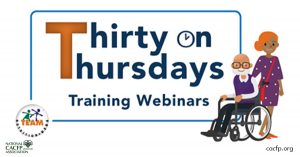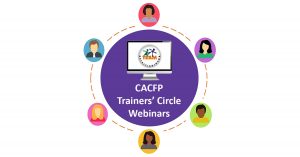Free Webinars
Identifying Whole Grain-Rich in the CACFP, Part 2 (Parte 2: Identificar alimentos ricos en grano integral en el CACFP)
This webinar will focus on how CACFP operators can use a food’s ingredient list to identify whole grain-rich items for their menus, with a focus on how to treat flour blends.
Este seminario web se enfoca en cómo los operadores del CACFP pueden usar la lista de ingredientes de un alimento para identificar alimentos ricos en grano integral para sus menús, incluyendo cómo tratar las mezclas de harinas.
Read MoreCreative Online Learning Strategies to Engage Providers
State agency staff from Iowa, Massachusetts, and Nebraska will share experiences in developing and implementing online learning modules.
Read MoreIdentifying Whole Grain-Rich in the CACFP Using the Ingredient List (Identificar alimentos ricos en grano integral para el CACFP usando la lista de ingredientes)
This webinar will focus on how CACFP operators can use a food’s ingredient list to identify whole grain-rich items for their menus.
Este seminario web se enfoca en cómo los operadores del CACFP pueden usar la lista de ingredientes de un alimento para identificar alimentos ricos en grano integral para sus menús.
Read MoreCoaching & Mentoring Using a Peer-to-Peer Model
This training will highlight effective training strategies used by the Kansas State Department of Education and resources from the Institute of Child Nutrition (ICN).
Read MoreFeeding Infants: Starting with Solids (Alimentación para bebés: comenzando con comidas sólidas)
This webinar focuses on how the CACFP infant meal pattern supports infant growth and development for babies ages 6 through 11 months. The webinar includes information on developmental readiness and feeding infants solid foods in the CACFP.
Este seminario web se enfoca en cómo el patrón de comidas para bebés del CACFP apoya el crecimiento y desarrollo de bebés de 6 a 11 meses. El seminario incluye información sobre cómo saber si un bebé está listo en su desarrollo para comer sólidos y acerca de alimentos sólidos en el CACFP.
Read MoreHow to Support Breastfeeding in the CACFP (Como puede apoyar la lactancia en el CACFP)
This webinar focuses on how child care centers and family child care homes that participate in the CACFP can support breastfeeding.
Este seminario web se enfoca en cómo los centros de cuidado infantil y los hogares de cuidado infantil que participan en el Programa de Alimentos para el Cuidado de Niños y Adultos (CACFP) pueden apoyar la lactancia materna.
Read MoreFeeding Infants: 0-5 Months (Alimentación para bebés de 0-5 meses)
This webinar focuses on how the Child and Adult Care Food Program (CACFP) infant meal pattern supports infant growth and development for babies ages birth through 5 months.
Este seminario web se enfoca en cómo el patrón de comidas para bebés del CACFP apoya el crecimiento y el desarrollo de bebés recién nacidos hasta los 5 meses de edad.
Read MoreAdding Whole Grains to Your Menu (Añada granos integrales a su menu)
This webinar focuses on how to offer whole grains at CACFP sites.
Este seminario web se enfoca en cómo ofrecer granos integrales en los sitios del CACFP.
Read MoreMethods for Healthy Cooking (Métodos para cocinar sano)
This webinar focuses on cooking nutritious meals and snacks in the CACFP, using methods such as roasting, baking, steaming, sautéing, stir-frying, grilling and more.
Este seminario web se enfoca en cocinar comidas y meriendas nutritivas en el CACFP, usando métodos como asar, hornear, al vapor, al sartén, a la parrilla y más.
Read MoreServing Meat & Meat Alternates at Breakfast (Servir carne y sustitutos de carne en el desayuno)
This webinar focuses on the option to serve meat and meat alternates in place of grains at breakfast up to three times per week for those following CACFP and preschool meal patterns.
Este seminario web se enfoca en la opción de servir carne y sustitutos de carnes en lugar de granos en el desayuno hasta tres veces por semana para quienes siguen el patrón de comidas para el CACFP y preescolares.
Read More

